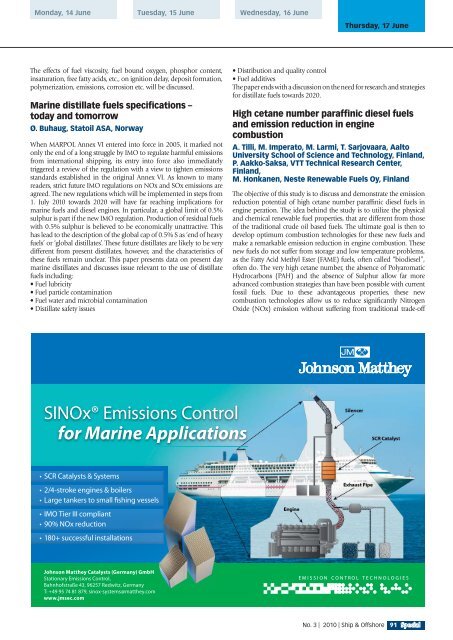CIMAC Congress - Schiff & Hafen
CIMAC Congress - Schiff & Hafen
CIMAC Congress - Schiff & Hafen
You also want an ePaper? Increase the reach of your titles
YUMPU automatically turns print PDFs into web optimized ePapers that Google loves.
Monday, 14 June<br />
Tuesday, 15 June Wednesday, 16 June<br />
The effects of fuel viscosity, fuel bound oxygen, phosphor content,<br />
insaturation, free fatty acids, etc., on ignition delay, deposit formation,<br />
polymerization, emissions, corrosion etc. will be discussed.<br />
Marine distillate fuels specifi cations –<br />
today and tomorrow<br />
Ø. Buhaug, Statoil ASA, Norway<br />
When MARPOL Annex VI entered into force in 2005, it marked not<br />
only the end of a long struggle by IMO to regulate harmful emissions<br />
from international shipping, its entry into force also immediately<br />
triggered a review of the regulation with a view to tighten emissions<br />
standards established in the original Annex VI. As known to many<br />
readers, strict future IMO regulations on NOx and SOx emissions are<br />
agreed. The new regulations which will be implemented in steps from<br />
1. July 2010 towards 2020 will have far reaching implications for<br />
marine fuels and diesel engines. In particular, a global limit of 0.5%<br />
sulphur is part if the new IMO regulation. Production of residual fuels<br />
with 0.5% sulphur is believed to be economically unattractive. This<br />
has lead to the description of the global cap of 0.5% S as ‘end of heavy<br />
fuels’ or ‘global distillates’. These future distillates are likely to be very<br />
different from present distillates, however, and the characteristics of<br />
these fuels remain unclear. This paper presents data on present day<br />
marine distillates and discusses issue relevant to the use of distillate<br />
fuels including:<br />
• Fuel lubricity<br />
• Fuel particle contamination<br />
• Fuel water and microbial contamination<br />
• Distillate safety issues<br />
SINOx® Emissions Control<br />
for Marine Applications<br />
• SCR Catalysts & Systems<br />
• 2/4-stroke engines & boilers<br />
• Large tankers to small fi shing vessels<br />
• IMO Tier III compliant<br />
• 90% NOx reduction<br />
• 180+ successful installations<br />
Johnson Matthey Catalysts (Germany) GmbH<br />
Stationary Emissions Control,<br />
Bahnhofstraße 43, 96257 Redwitz, Germany<br />
T: +49 95 74 81 879, sinox-systems@matthey.com<br />
www.jmsec.com<br />
Thursday, 17 June<br />
• Distribution and quality control<br />
• Fuel additives<br />
The paper ends with a discussion on the need for research and strategies<br />
for distillate fuels towards 2020.<br />
High cetane number paraffi nic diesel fuels<br />
and emission reduction in engine<br />
combustion<br />
A. Tilli, M. Imperato, M. Larmi, T. Sarjovaara, Aalto<br />
University School of Science and Technology, Finland,<br />
P. Aakko-Saksa, VTT Technical Research Center,<br />
Finland,<br />
M. Honkanen, Neste Renewable Fuels Oy, Finland<br />
The objective of this study is to discuss and demonstrate the emission<br />
reduction potential of high cetane number paraffi nic diesel fuels in<br />
engine peration. The idea behind the study is to utilize the physical<br />
and chemical renewable fuel properties, that are different from those<br />
of the traditional crude oil based fuels. The ultimate goal is then to<br />
develop optimum combustion technologies for these new fuels and<br />
make a remarkable emission reduction in engine combustion. These<br />
new fuels do not suffer from storage and low temperature problems,<br />
as the Fatty Acid Methyl Ester (FAME) fuels, often called “biodiesel”,<br />
often do. The very high cetane number, the absence of Polyaromatic<br />
Hydrocarbons (PAH) and the absence of Sulphur allow far more<br />
advanced combustion strategies than have been possible with current<br />
fossil fuels. Due to these advantageous properties, these new<br />
combustion technologies allow us to reduce signifi cantly Nitrogen<br />
Oxide (NOx) emission without suffering from traditional trade-off<br />
No. 3 | 2010 | Ship & Offshore<br />
91

















